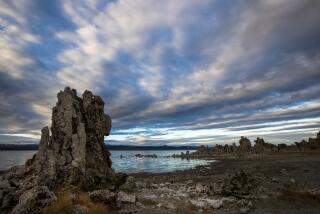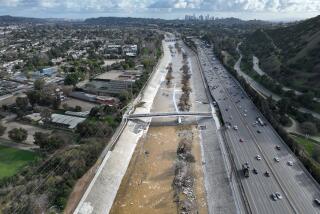‘There It Is. Take It . . .’ : . . . and for 75 Years, the City Has
Thousands of gallons of Los Angeles Aqueduct water, which normally plunges into the San Fernando Valley inside pipes that feed a hydroelectric plant, were instead unleashed over the Sylmar cascades Thursday morning to mark the 75th anniversary of the system’s christening.
As the water swirled down both the 1913 and the 1970 channels of the cascades, wind whipped up a cloud of spray, forming multiple rainbows and chilling some of the dozens of city notables who shivered alongside Los Angeles Department of Water and Power employees dressed in turn-of-the-century costumes.
“It’s hypnotic, isn’t it?” asked Catherine Mulholland, the granddaughter of former city water superintendent William Mulholland, credited with making the aqueduct dream a reality.
It was William Mulholland who gave the signal to turn on the water for the first time 75 years ago this month, declaring: “There it is. Take it.” That event was witnessed by an estimated 40,000 people.
Seven years later, piping for the first hydroelectric plant was installed alongside the concrete channels and the cascades were left dry. The cascades have been used since only as overflow channels--and for special events.
Frequent Visitor
Mulholland’s great-granddaughter, Kathleen Parker, said that although she had visited the site frequently with her grandparents, she had not fathomed its significance until Thursday. She was so inspired, she hiked in high heels to the top of the older cascade.
“Growing up, I always felt that the most famous thing was that a street was named after him,” Parker said, catching her breath after the trek. “It really hit me today, what he did. “
The aqueduct quenches three-fourths of the city’s huge thirst by draining water from the eastern slopes of the Sierra Nevada--namely Owens Valley and, with a 1940 extension, the Mono basin. The balance comes from San Fernando Valley wells, the Colorado River and Northern California, said Ed Freudenburg, spokesman for the Department of Water and Power.
From the base of the cascades, the water flows through a filtration plant and is piped into Valley homes.
Born of visionary engineering and clever real estate deals, the 338-mile aqueduct system was a developer’s boon.
During his speech Thursday, Mayor Tom Bradley called William Mulholland and city engineer Fred Eaton geniuses.
“They enabled the city to grow into the great city it has become,” Bradley said as he looked out over the Valley’s sprawl, visible Thursday as it is only on those rare days when the wind keeps away a shroud of smog.
The story of the waterway’s inception was tailor-made for Hollywood, a fact that did not escape producers who backed the 1974 movie, “Chinatown,” which includes a fictionalized account of the struggle to bring water to Los Angeles.
In the real-life version, the characters were just as motivated as their big-screen counterparts.
Mulholland, an Irishman, rose in fewer than 10 years from tender of river ditches for the Los Angeles water company to superintendent of the city’s water system and manager of the aqueduct project.
Eaton, a Los Angeles city engineer, first recognized Owens Valley’s water potential in 1892 and shared his vision with Mulholland 12 years later, when the city was in the throes of a major drought.
Hero Status
While Mulholland’s efforts to win passage of a $24.5-million bond issue for the water project raised him to hero status in Los Angeles, he was considered a villain at the water’s source in Owens Valley. It was too late to change history by the time that Owens Valley ranchers realized that the city of Los Angeles had bought up most of their region’s land, along with the rights to pump the water from it.
Even Eaton became disillusioned with Mulholland and with the project by 1913, said his grandson, John Eaton, who brought his two sons to Thursday’s celebration. Fred Eaton owned a ranch near Owens Valley, and he joined in the landowners’ fight for their water rights.
In fact, John Eaton said his grandfather had refused to attend the aqueduct’s unveiling.
“He was angry. It’s very complicated, but there was some kind of estrangement between him and Mulholland,” Eaton said. “But then, as my aunt used to say, ‘They were all pirates.’ ”
More to Read
Sign up for Essential California
The most important California stories and recommendations in your inbox every morning.
You may occasionally receive promotional content from the Los Angeles Times.










